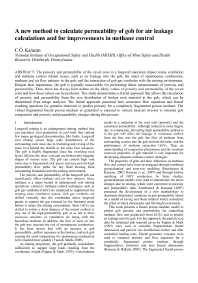Mining Publication: A New Method to Calculate Permeability of Gob for Air Leakage Calculations and for Improvements in Methane Control
Original creation date: June 2010
The porosity and permeability of the caved zone in a longwall operation impact many ventilation and methane control related issues, such as air leakage into the gob, the onset of spontaneous combustion, methane and air flow patterns in the gob, and the interaction of gob gas ventholes with the mining environment. Despite their importance, the gob is typically inaccessible for performing direct measurements of porosity and permeability. Thus, there has always been debate on the likely values of porosity and permeability of the caved zone and how these values can be predicted. This study demonstrates a fractal approach that allows the calculation of porosity and permeability from the size distribution of broken rock material in the gob, which can be determined from image analyses. The fractal approach presented here constructs flow equations and fractal crushing equations for granular materials to predict porosity for a completely fragmented porous medium. The virtual fragmented fractal porous medium so generated is exposed to various uniaxial stresses to simulate gob compaction and porosity and permeability changes during this process.
Authors: CÖ Karacan
Conference Paper - June 2010
NIOSHTIC2 Number: 20036993
Proceedings of the 13th U.S./North American Mine Ventilation Symposium, Sudbury, Ontario, Canada, June 13-16, 2010. Hardcastle, McKinnon, eds., Sudbury, Ontario, Canada: MIRARCO - Mining Innovation, 2010; :273-282
See Also
- Computational Fluid Dynamics Modeling of Spontaneous Heating in Longwall Gob Areas
- Control of Longwall Gob Gas With Cross-Measure Boreholes (Upper Kittanning Coalbed)
- Degasification System Selection for U.S. Longwall Mines Using an Expert Classification System
- Effect of Longwall Face Advance on Spontaneous Heating in Longwall Gob Areas
- Methane Diffusion Parameters for Sized Coal Particles: A Measuring Apparatus and Some Preliminary Results
- A Methodology for Determining Gob Permeability Distributions and its Application to Reservoir Modeling of Coal Mine Longwalls
- A Numerical Evaluation on the Effects of Impermeable Faults on Degasification Efficiency and Methane Emissions During Underground Coal Mining
- Probabilistic Modeling Using Bivariate Normal Distributions for Identification of Flow and Displacement Intervals in Longwall Overburden
- Stochastic Modeling of Gob Gas Venthole Production Performances in Active and Completed Longwall Panels of Coal Mines
- Underground Gob Gas Drainage During Longwall Mining
- Page last reviewed: 9/21/2012
- Page last updated: 9/21/2012
- Content source: National Institute for Occupational Safety and Health, Mining Program


 ShareCompartir
ShareCompartir
